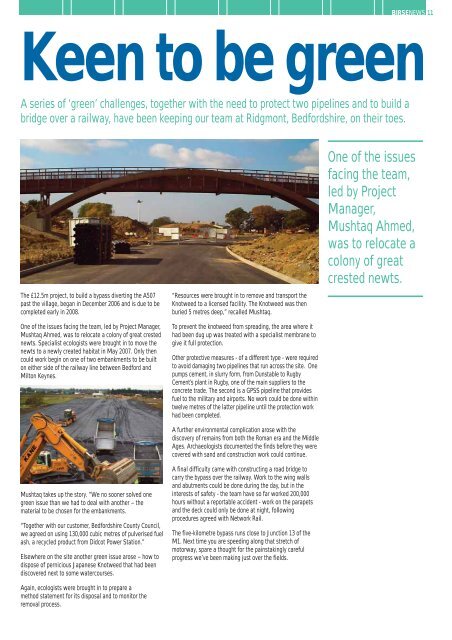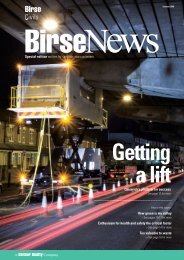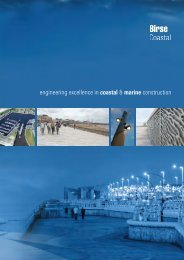Create successful ePaper yourself
Turn your PDF publications into a flip-book with our unique Google optimized e-Paper software.
BIRSENEWS 11<br />
Keen to be green<br />
A series of ‘green’ challenges, together with the need to protect two pipelines and to build a<br />
bridge over a railway, have been keeping our team at Ridgmont, Bedfordshire, on their toes.<br />
The £12.5m project, to build a bypass diverting the A507<br />
past the village, began in December 2006 and is due to be<br />
completed early in 2008.<br />
One of the issues facing the team, led by Project Manager,<br />
Mushtaq Ahmed, was to relocate a colony of great crested<br />
newts. Specialist ecologists were brought in to move the<br />
newts to a newly created habitat in May 2007. Only then<br />
could work begin on one of two embankments to be built<br />
on either side of the railway line between Bedford and<br />
Milton Keynes.<br />
Mushtaq takes up the story. “We no sooner solved one<br />
green issue than we had to deal with another – the<br />
material to be chosen for the embankments.<br />
“Together with our customer, Bedfordshire County Council,<br />
we agreed on using 130,000 cubic metres of pulverised fuel<br />
ash, a recycled product from Didcot Power Station.”<br />
Elsewhere on the site another green issue arose – how to<br />
dispose of pernicious Japanese Knotweed that had been<br />
discovered next to some watercourses.<br />
Again, ecologists were brought in to prepare a<br />
method statement for its disposal and to monitor the<br />
removal process.<br />
“Resources were brought in to remove and transport the<br />
Knotweed to a licensed facility. The Knotweed was then<br />
buried 5 metres deep,” recalled Mushtaq.<br />
To prevent the knotweed from spreading, the area where it<br />
had been dug up was treated with a specialist membrane to<br />
give it full protection.<br />
Other protective measures - of a different type - were required<br />
to avoid damaging two pipelines that run across the site. One<br />
pumps cement, in slurry form, from Dunstable to Rugby<br />
Cement’s plant in Rugby, one of the main suppliers to the<br />
concrete trade. The second is a GPSS pipeline that provides<br />
fuel to the military and airports. No work could be done within<br />
twelve metres of the latter pipeline until the protection work<br />
had been completed.<br />
A further environmental complication arose with the<br />
discovery of remains from both the Roman era and the Middle<br />
Ages. Archaeologists documented the finds before they were<br />
covered with sand and construction work could continue.<br />
A final difficulty came with constructing a road bridge to<br />
carry the bypass over the railway. Work to the wing walls<br />
and abutments could be done during the day, but in the<br />
interests of safety - the team have so far worked 200,000<br />
hours without a reportable accident - work on the parapets<br />
and the deck could only be done at night, following<br />
procedures agreed with Network Rail.<br />
The five-kilometre bypass runs close to Junction 13 of the<br />
M1. Next time you are speeding along that stretch of<br />
motorway, spare a thought for the painstakingly careful<br />
progress we’ve been making just over the fields.<br />
One of the issues<br />
facing the team,<br />
led by Project<br />
Manager,<br />
Mushtaq Ahmed,<br />
was to relocate a<br />
colony of great<br />
crested newts.




